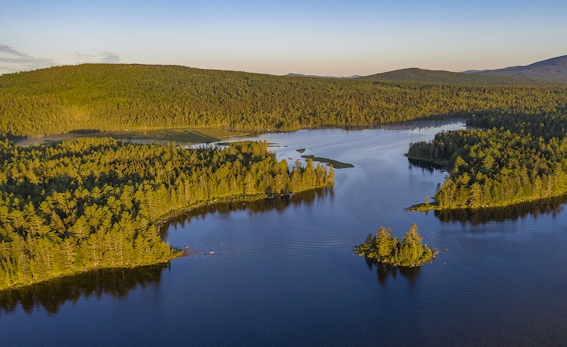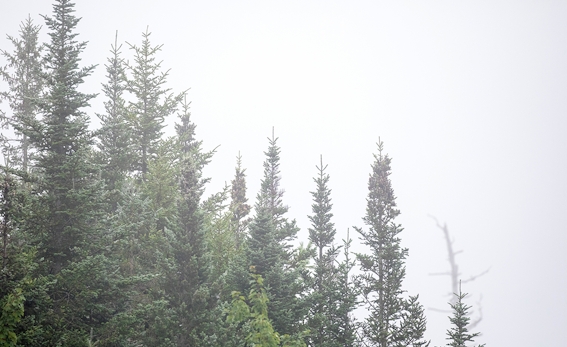Fifty Years of Championing New England Forestry Foundation
This June, as pollen hung thick in the air at New England Forestry…

In March 2001, New England Forestry Foundation and the Pingree family completed the largest forestland conservation easement in the history of the United States, and pioneered a new scale of land conservation while they were at it. This success has made NEFF one of the six largest land trusts in the nation by acres conserved.
Three and a half times the size of Baxter State Park and larger than the state of Rhode Island, the Pingree easement conserves some of the most spectacular natural resources in Maine, including the Allagash Lakes, 2,000 miles of river frontage and Maine’s most productive Peregrine Falcon nesting area.
.
NEFF conserves its Community Forests through ownership, and they are open daily, free to visit, and offer outdoor recreation opportunities. Unlike NEFF’s Community Forests, land protected by NEFF conservation easements—a legal tool—aren’t open to visitors unless their owners explicitly state so, because many belong to private individuals.
NEFF uses easements to conserve land owned by others. When a landowner grants NEFF an easement, it means they have permanently donated or sold to NEFF the landowner’s right to develop their own property, while the landowner otherwise retains ownership of their land; NEFF ensures the easements’ terms are met and enforced.

New England Forestry Foundation has created a custom monitoring system—complete with aerial photography missions and bushwhacking excursions—that allows us to steward our two landscape-scale easement projects: the 762,000-acre Pingree easement and the Downeast Lakes Forestry Partnership, through which NEFF conserved 335,000 acres via easement.
NEFF’s primary responsibility as an easement holder is to make sure the property’s natural resources are protected in keeping with the easement terms. Every NEFF easement is uniquely crafted to match the goals of the landowner and the natural resources present on the land, and so there is no one-size-fits-all approach to stewardship. The scale of the Pingree and Downeast Lakes easements initially created a challenge for NEFF, as we had never before attempted easement-monitoring of such large properties, and neither had anyone else! NEFF has since crafted and adapted a streamlined easement inspection process that has proven successful. Read about it in our Stewarding a Landscape blog post.
The Pingree easement is so vast it manages to protect 16 miles along the St. John River and portions of the Cupsuptic, Black, Little Black, St. John, Machias, and Aroostook Rivers, as well as Upper Richardson, Kennebago, Munsungan, Loon, Caucomgomoc, Eagle, Chamberlain, Allagash, Mooseleuk, and Churchill Lakes. The forests contain numerous active Bald Eagle nests, 24,800 acres of managed deeryards, 72,000 acres of wetland habitat, and at least 67 rare and endangered plant sites.

Kennebago River and West Kennebago Mountain
In 1999, NEFF announced a ground-breaking venture in land conservation: The Pingree Forest Partnership. It would pioneer a new scale of conservation and preserve remarkable Maine resources, and it also presented a stupendous fundraising challenge for NEFF’s leadership. Thankfully, two of New England’s leading conservation families stepped up.
In the mid-1800s, David Pingree, Sr. first invested in Maine’s timberlands. By the 20th century, Pingree family members were recognized as leaders in sustainable management. The Pingree forest was the first in the world to be “Green Certified” by two independent third-party certifiers. Meanwhile, the Merck-Hatch-Henry family’s roots go back to America’s first forester, Carl Schenck, who demonstrated the power and beauty of scientific forestry on the Biltmore Estate in North Carolina.
Once the Pingree heirs agreed to the terms of the easement deal, NEFF wisely recruited the one person they knew could skillfully helm the boat and meet the fundraising challenge head-on: Bayard Henry, a dedicated and long-serving member of NEFF’s Board of Directors. As Campaign Chair, he proceeded to successfully raise the campaign’s target of $30 million in 12 months, and in 2001, NEFF purchased the conservation easement on more than 762,192 acres.
“The family is very pleased to have worked with New England Forestry Foundation to conserve this magnificent Maine forestland,” said Steve Schley, the then-president of Pingree Associates, Inc., agents for the Pingree family. “Now we can move forward with our primary objective of managing our forests sustainably, and contributing to the forest economy of Maine.”
More than 45 foundations, both large and small, contributed to the success of the project, including The John Merck Fund and the Merck Family Fund, each of which provided major lead gifts to launch the fundraising initiative. The Libra Foundation made the largest single gift from a Maine-based foundation. Generous grants also were received from the Elmina B. Sewall Foundation, the National Fish and Wildlife Foundation, the Kresge Foundation, the Sudbury Foundation, the Betterment Fund, the Rockefeller Brothers Fund, the North American Wetlands Conservation Act fund, and the agencies involved with the North Cape Oil Spill (U.S. Fish and Wildlife Service, Rhode Island Department of Environmental Management, and the National Oceanic and Atmospheric Administration).
More than 1,000 individuals also contributed to the success of this project, including $831.42 from the children at Breakwater School in Portland, Maine, who conducted a penny drive to raise the funds. Further, the acreage protected was increased thanks to participation of the Maine Chapter of The Nature Conservancy. Its financial support and the addition of forested acres from its acquisition added protection for the St John River and Big Reed Pond.
A broad coalition formed among the state’s various conservation, sporting, and business organizations to support the purchase of the Pingree easement. Participants included the Forest Society of Maine, Sportsmen’s Alliance of Maine, Maine Audubon Society, Northern Forest Alliance, Chewonki Foundation, Maine AFL-CIO, Maine Forest Products Council, Maine Professional Guides, Natural Resources Council of Maine, Rangeley Lakes Heritage Trust, Ducks Unlimited, Maine Appalachian Trail Club, Maine Coast Heritage Trust, Maine Council of Trout Unlimited, Maine Snowmobile Association, Maine Sporting Camp Association, Maine State Chamber of Commerce, Businesses for the Northern Forest, and the Maine Tourism Association.